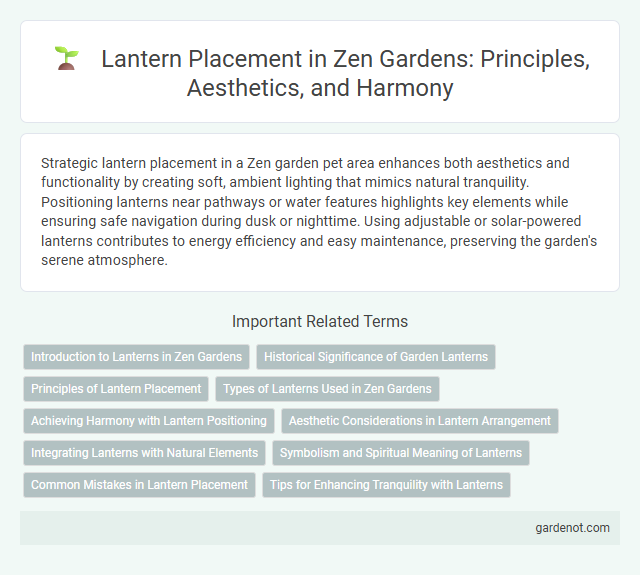Strategic lantern placement in a Zen garden pet area enhances both aesthetics and functionality by creating soft, ambient lighting that mimics natural tranquility. Positioning lanterns near pathways or water features highlights key elements while ensuring safe navigation during dusk or nighttime. Using adjustable or solar-powered lanterns contributes to energy efficiency and easy maintenance, preserving the garden's serene atmosphere.
Introduction to Lanterns in Zen Gardens
Lanterns in Zen gardens symbolize illumination and spiritual guidance, often crafted from stone to blend naturally with the landscape. Strategically placing lanterns near pathways, water features, or significant garden elements enhances both aesthetic appeal and meditative atmosphere. These lanterns not only provide subtle lighting but also serve as focal points that embody balance and harmony within the garden's design.
Historical Significance of Garden Lanterns
Garden lanterns in Zen gardens trace back to ancient Japan, serving both practical and spiritual purposes by illuminating paths and symbolizing enlightenment. Traditionally crafted from stone, these lanterns embody wabi-sabi aesthetics, emphasizing simplicity and natural beauty. Their placement near water features or along walkways enhances the serene atmosphere while connecting garden design to Buddhist philosophy.
Principles of Lantern Placement
Lantern placement in a Zen garden follows principles emphasizing balance, harmony, and natural flow, often positioned near water features or along winding paths to highlight tranquility. Strategic placement enhances the garden's aesthetic and spiritual ambiance by casting subtle, calming light that complements surrounding rocks and plants. Proper spacing ensures the lanterns create a rhythm that guides meditation and reflection without overpowering the natural landscape.
Types of Lanterns Used in Zen Gardens
Stone lanterns, known as "Ishidoro," are the most traditional and integral types used in Zen gardens, offering a timeless aesthetic that blends natural elements with subtle illumination. Bronze and metal lanterns provide durability and a modern touch while maintaining the garden's serene ambiance during twilight. Ceramic lanterns, often handcrafted, introduce artistic flair and delicate textures, enhancing the Zen garden's meditative environment.
Achieving Harmony with Lantern Positioning
Lantern placement in a Zen garden is crucial for achieving harmony by balancing light, shadow, and natural elements to create a serene atmosphere. Positioning lanterns near water features, pathways, or stones enhances visual flow and mindfulness, emphasizing simplicity and tranquility. Strategic placement respects traditional Japanese aesthetics, fostering a contemplative space that invites peaceful reflection.
Aesthetic Considerations in Lantern Arrangement
Lantern placement in a Zen garden emphasizes balance, harmony, and visual flow to enhance its tranquil ambiance. Strategically positioning lanterns near stones, water features, or along pathways creates focal points that guide the viewer's eye and accentuate natural textures. The soft illumination from traditional stone lanterns (ishidoro) highlights key elements without overwhelming the serene landscape, maintaining minimalist aesthetics.
Integrating Lanterns with Natural Elements
Lanterns in a Zen garden are strategically placed near rocks, water features, or moss to create harmonious visual balance and enhance tranquility. The soft glow from stone or metal lanterns highlights natural textures, fostering a seamless blend between light and landscape. Thoughtful lantern integration emphasizes subtle contrast and complements the garden's serene atmosphere.
Symbolism and Spiritual Meaning of Lanterns
Lantern placement in a Zen garden symbolizes illumination, enlightenment, and guidance along the spiritual path. Traditionally, stone lanterns represent the dispelling of darkness and ignorance, illuminating the mind and soul. Positioned near water or along pathways, these lanterns enhance meditation and foster a serene atmosphere that supports mindfulness and inner peace.
Common Mistakes in Lantern Placement
Common mistakes in lantern placement within a Zen garden include positioning lanterns too symmetrically or too close to pathways, disrupting the natural flow and aesthetic balance. Overlooking the scale and proportion of lanterns relative to surrounding elements can result in visual imbalance, diminishing the garden's tranquil ambiance. Proper placement considers subtle integration with moss, rocks, and plants to enhance harmony and spiritual symbolism.
Tips for Enhancing Tranquility with Lanterns
Position lanterns along winding paths and near water features in a Zen garden to create soft, harmonious lighting that enhances tranquility. Choose lanterns made from natural materials like stone or bamboo to blend seamlessly with the garden's aesthetic. Illuminate focal points such as bonsai trees or rock arrangements to emphasize meditation areas and foster a serene atmosphere.
Lantern placement Infographic

 gardenot.com
gardenot.com